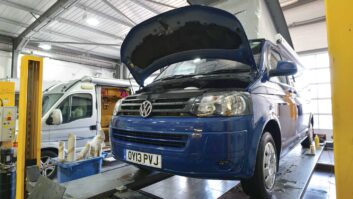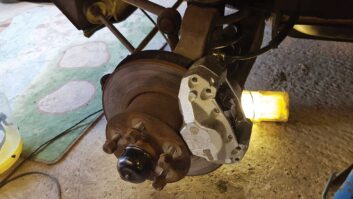Most of us are aware of and careful with our car tyres, even the spare, but it’s a very different matter with motorhome rubber, which can stand all through the winter without
a moment’s thought and can even be woefully neglected all year round. But a careless attitude towards your motorhome tyres can have several negative effects on the only thing that you have lying between your 3500kg+ ‘van and the road.
Even if you have the best motorhome, you’ll want to make sure you look after your tyres. In this guide, we’re going through the crucial elements of motorhome tyre safety, including a look at tyre anatomy, understanding the common issues that can occur, the different markings they can have, and the safety devices that are out there.
Don’t forget to make sure you keep an eye on your motorhome tyre pressure too.
You can navigate to a specific section by using the menu below too.
Motorhome tyres: all you need to know
Anatomy of a tyre
Problems with motorhome tyres
Tyre markings
Load rating
Driving in mud, snow and winter
Tyre safety devices
The different types of tyre
Anatomy of a motorhome tyre
The ridged surface of the motorhome tyre, which is known as the tread, features tread grooves (typically over 2mm in width) in different patterns.
Finer grooves, known as sipes, are also visible on many tyres. Both types of groove are designed to improve grip, especially when driving in the wet or on snow and ice.
They are shaped and angled to remove the maximum amount of water from between the tyre and the road surface, with the patterns varying widely, depending on the tyres’ purpose, the country and the time of year.
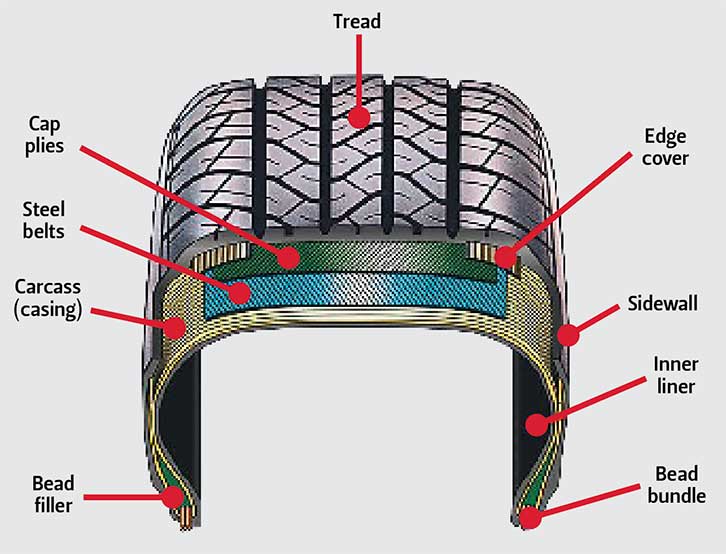
Sidewalls give the tyre its strength and rigidity. High-performance tyres generally have very slim walls, even down to 2-3cm, because they give excellent cornering performance. Ride quality, on the other hand…
Motorhome tyres tend to be quite high-profile (deeper), because they need to soak up as much of the road impact as possible.
Problems with motorhome tyres
There are numerous motorhome mistakes to avoid when you’re a ‘van owner – here, we’re sharing some of the most common tyre issues you won’t want to overlook.
Tyre wear
This is potentially dangerous to your health and your wallet. The law states that you should have at least 1.6mm of tread depth spread evenly across three-quarters of the width of the rubber. That 1.6mm is the equivalent of the lip around the edge of a 20p coin, so consider keeping one in your vehicle for monthly checks. Fines for bald tyres are up to £2500, with three points on your licence for good measure. Oh, that’s per tyre!
If the tyre is really old, it could look more like a slick, with no tread right across its width, but it’s more common to see extreme wear limited to just one or two areas of the tyre.
If both edges of the tyre are worn, this suggests that you have been driving the ’van with under-inflated tyres, which adds stress and wear to the shoulders of the rubber. Having little or no grip here can affect your cornering to a dangerous degree. Conversely, over-inflation results in wear to the tread in the middle of the tyre, as the rubber is ballooned out. This can affect both grip and tyre life.
If your tyre is unevenly worn on the inner or outer edges, this suggests a wheel alignment problem (you might have hit a pothole) and you should have your wheels professionally checked immediately. You can expect to pay from around £30 for two-wheel tracking, and from £60 to £100 for all four wheels.
The procedure should take about 30 minutes and your technician will be able to tell you how far the alignment was out.
Of course, it’s easy to spot extreme tyre wear on the outside of the wheel, but much trickier on the inside, so always take the time to (safely) check when you’re preparing your motorhome for the new season and before leaving on a trip.
UV deterioration
Tyre compounds are damaged by the UV radiation in sunlight. The stronger the sun, the more UV they get. This is one of the reasons motorhome tyres should be replaced every five years, even if they have good tread left.
Cleaning your tyres and coating them in a good-quality tyre-dressing will slow the degradation and maintain the compounds, so don’t forget them when you’re cleaning your motorhome – you’ll make your ‘van look even better!
Cracking and blistering
Degradation comes in many forms, but one of the most obvious is fine cracks in the sidewall. If this happens, and certainly if the cracks are larger, you should replace the tyre.
Blistering is caused by a weak spot in the tyre (usually in the wall), perhaps the result of a fault in the manufacturing, but more likely, through a significant impact to a small area of the tyre, for example, from hitting the kerb. Again, replace immediately.
Delamination
Tyres are constructed in layers. A combination of polymers, textile and fillers, natural rubber and steel strands is used to give the tyre its strength, comfort and safety characteristics.
Delamination occurs when a bonded layer separates from the one below, often causing the tread to flap away from the tyre. This is not only dangerous, and a precursor to total tyre failure, but the flailing strips of tyre ‘rubber’ can damage your ’van bodywork as the wheel rotates.
Damage
Punctures, gashes or chunks of missing compound are the most common faults with tyres, and are often caused by hitting debris in the road, or a kerbstone. While the damage might look superficial, it will cause your motorhome to fail its MoT, and any good technician will always advise you to change the tyres.
Tyre markings
Before replacing a tyre, you should determine what you currently have. Tyres are sized in a mixture of imperial and metric numbers. Attempts have been made to metricate them –
by Michelin in 1975, with their TRX tyre – but the novelty proved short-lived.
So if your Ducato has 225/75-R16 stamped on the tyre sidewall, it means the tread is 225mm wide and the inner diameter is 16 inches.
The ‘75’ is the aspect ratio – the height of the sidewall as a percentage of the tread width – so this tyre would have a sidewall that’s 75% of the tread width, 169mm in this case. A lower-profile tyre will have a smaller aspect ratio.
The ‘R’ simply refers to the tyre having a radial construction (older tyres had a different weave of plies, but most modern tyres are now radial).
Load rating
As well as the size, you’ll find other numerals on your tyre – CP 112Q is a common one. ‘CP’ refers to a camping tyre, which is specifically designed for motorhome use. Those marked ‘C’ are regular commercial tyres. There is no legal requirement to use a camping tyre, but if you can afford them, they’re the best choice.
The ‘112’ is crucial – this is the load index, the capacity the tyre is rated to support. In this case, each individual tyre can support a maximum load of 1120kg, a maximum of 4480kg in the case of a four-wheeled motorhome, 6720kg for a tag-axle.
Never buy a tyre with a lower weight limit than the original fitment. You can go for a higher load rating, but this comes at the expense of a stiffer sidewall, which can make ride quality harsher.
The wheel itself must also be load rated. Check with your supplier that it is rated for your vehicle – they should supply paperwork to support this. Never use car wheels on campervans – they’re not load rated and can fail.
The ‘Q’, the speed rating, must be higher than the vehicle’s maximum design speed (Q is 99mph). The AA provide a good list of speed ratings,.
Mud and snow, or winter?
Many motorhome tyres also have ‘M+S’ stamped on them, for ‘mud and snow’. This means they will have some ability in muddy conditions and can tolerate a little snow. It does not mean they are the best tyre for a trip to Scandinavia, but for most motorhomes, they are a good choice.
If you use only grass pitches or venture further off paved roads, off-road tyres can cope with mud far better. The downside is that the more aggressive the tread pattern, the noisier
the tyre will be on the road and the worse it will handle.
For winter snow, the next step up from an M+S tyre is a winter tyre. Confusingly, some M+S tyres are winter tyres and some are not – consult your tyre maker. Winter tyres use a compound that is designed to stay supple in lower temperatures.
The best for winter use is a winter tyre carrying the Three-Peak Mountain Snow Flake (3PMSF) stamped into the sidewall. This means it meets European standards for cold-weather use.
For year-round use, or if you live in Scotland, look for winter tyres marked M+S and 3PMSF. They are going to be suitable when you decide to embark on that epic trip to Norway!
Don’t take any unnecessary risks by purchasing part-worn or retreaded tyres; always buy the best that you can afford. Ideally, choose rubber from a recognised brand, or select one of the good secondary brands.
Without getting into too much of the science, the general rule is that there is always going to be a pay-off with tyre characteristics.
Softer tyres will give better grip in the dry, but wear significantly faster, while tyres with lots of grooving might offer better grip in the wet, but will produce more road noise.
As mentioned previously, it’s well worth considering using a good tyre-dressing on your motorhome rubber once a month.
Tyre safety devices
You can’t plan for any damaging potholes, road debris, or even a poorly made tyre, so there are a number of smart devices to prevent a tyre problem from turning into a driving nightmare. One safety item that you could invest in is a tyre pressure sensor.
TyrePal and Snooper Tyre Pilot
Both of these tyre pressure sensor systems can be used on a motorhome. A control display unit sits on your dash, and is wirelessly connected to sensors on each of your tyre valves. If these detect a drop in pressure, the display unit will alert you.
TyrePal is not only a useful aid in the event of a sudden loss of tyre pressure, such as a major puncture – it will also draw your attention to slow punctures that otherwise might go undetected until it’s too late. In this way, they will increase the longevity of your tyres, which might suffer excess wear from under-inflation.
TyrePal costs from around £115 for a solar-powered monitor with four sensors. Snooper’s Tyre Pilot, with four sensors, is available online from as little as £19.99.
If you’re looking to retrofit one, check out our guide to fitting a tyre pressure monitoring system.
The different types of tyre
Both car and motorhome tyres are covered in numbers and letters – a kind of secret code describing their size, age and function
The size of the motorhome tyre
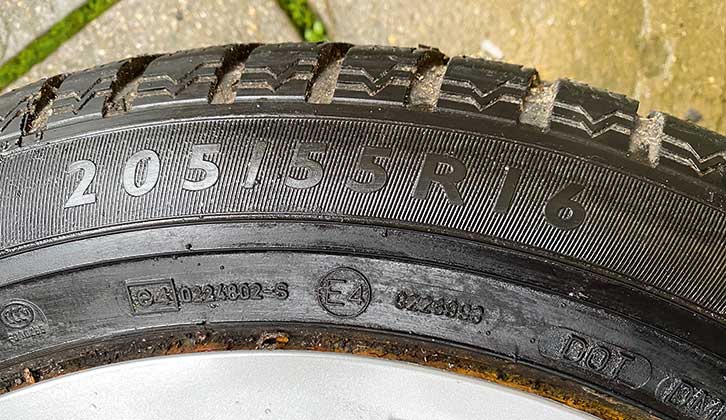
In the above example, the tyre size is 205/55 R 16. Here, 205 denotes the width of the tyre in millimetres, as measured from shoulder to shoulder.
The 55 displays the profile or aspect ratio of the tyre (the depth of the sidewall). This is expressed as a percentage of the width, so here, the depth of the tyre is 55% of its 205mm width.
R shows that this tyre has a radial construction: the cord plies cross the tyre at 90° to the direction of travel.
The 16 shows the diameter of the wheel rim that the tyre is designed to fit, measured in inches.
Motorhome/campervan tyres will also state ‘CP’ on the sidewall, and will (crucially) feature a load index (see p91) – you should pay extra attention to this.
Ratings of the tyre

Here, H denotes the speed rating (p91), which is measured on a scale of A to Y. The H indicates a tyre rated to travel at up to 130mph. The top rating, Y, is 186mph-plus! The 91
is the tyre load index. This tyre can carry up to 615kg in weight; 92 is 630kg, 93 is 650kg, and so on.
Date of manufacture

This four-digit code displays the week and year that the tyre was made. For example, 1219 is the 12th week of 2019.
Type of tyre
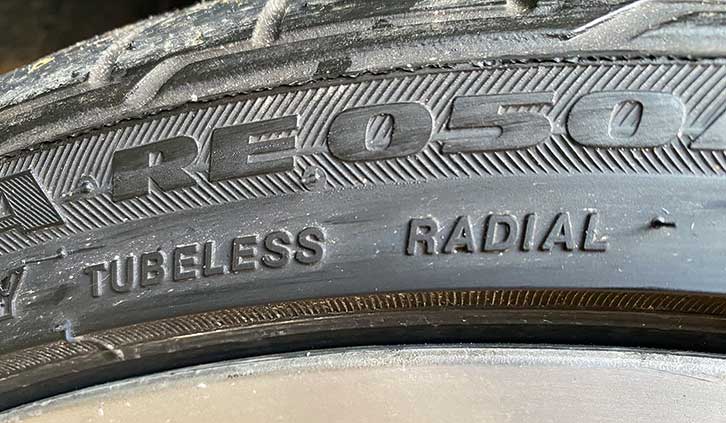
Here the words ‘Tubeless’ and ‘Radial’ denote the type of tyre and its design/structure.
RunFlat tyres

Tyres that maintain their shape and performance, even when deflated, are commonly found on modern cars, as manufacturers do away with spare wheels. RunFlat tyres
are very rigid, to the point that many think they spoil the ride, but if you do have a puncture, you can typically drive up to 50 miles at 50mph (although the slower you can go, the better).
RunFlats cost more than standard tyres and, of course, you need a pressure monitoring system, or you would never know if the tyre had deflated! I have yet to see this technology used on a motorhome tyre, but it’s very often standard on higher-end car brands.
If you’re looking for more tips for staying safe on the road, be sure to check out our motorhome driving tips guide.
Written by John Sootheran and Peter Rosenthal.
Future Publishing Limited, the publisher of Practical Motorhome, provides the information in this article in good faith and makes no representation as to its completeness or accuracy. Individuals carrying out the instructions do so at their own risk and must exercise their independent judgement in determining the appropriateness of the advice to their circumstances. Individuals should take appropriate safety precautions and be aware of the risk of electrocution when dealing with electrical products. To the fullest extent permitted by law, neither Future nor its employees or agents shall have any liability in connection with the use of this information. Double check any warranty is not affected before proceeding.
If you’ve enjoyed reading this article, why not get the latest news, reviews and features delivered direct to your door or inbox every month. Take advantage of our brilliant Practical Motorhome magazine SUBSCRIBERS’ OFFER and SIGN UP TO OUR NEWSLETTER for regular weekly updates on all things motorhome related.






